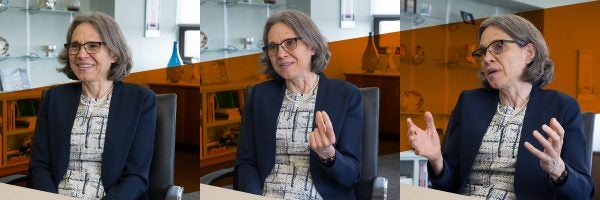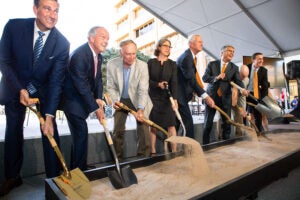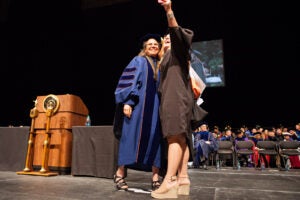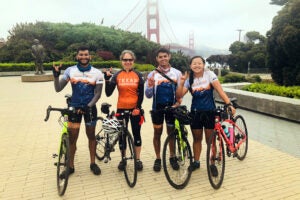
Sharon Wood does not start her day with coffee; she gave up caffeine during her undergraduate days. Instead, she starts by running or cycling. This will not surprise anyone who knows the hardworking, early rising engineer who, on July 19, becomes UT’s No. 2, the executive vice president and provost. “I drink cold water,” she says.
Wood grew up in central New Jersey, with a father in construction. “When I was a little kid, he was working for a contractor who built industrial steel structures — and that’s how I got interested in structural engineering. When I was about 8, I got to walk around on the construction site and up in the beams, and I thought that engineering would be fun. During the recession in 1972, he started an asphalt paving company, and that’s where he spent most of his career. I did work for him the summer after my first year of college. The asphalt is 300 degrees below you, it’s hot above you, and it’s a demanding physical job. The experience convinced me to spend a lot of time studying!”
She is proud to be a fourth-generation civil engineer; her father, grandfather and great-grandfather were all in the trade. The fact that she is the first woman in that professional genealogy bestows a certain pioneer status on her, and having become a leader in a historically male-dominated field has not gone unnoticed.
By the way, her parents, both in their 80s, are still working. Her father is now a building inspector. “On all these local construction projects, he knows all the shortcuts, and he’s never afraid to call them out!” Wood’s brother is a CPA, and their mother works in his office.
An athlete from early on, as an undergraduate at the University of Virginia, she was on the rowing team, and yes, she is currently reading “The Boys in the Boat.” She also played bassoon in the orchestra. Look at her iTunes account today and you will see an eclectic music mix, with the last album played being “Joe Ely Live from the Cactus Cafe.” But get into her car and it’s NPR all the way. Her go-to meal is some kind of vegetable — broccoli, broccolini or spinach — some sort of tofu, and rice or potatoes.
We spoke in her 10th floor office at the Cockrell School of Engineering on June 30, a moving box here and there in her waning days as dean.
As an expert in structural engineering, what are your thoughts on the events of the day, the structural disaster in Surfside, Florida?
It really highlights the importance of preventative maintenance — which most people don’t do — and having periodic inspections. We have an inventory of bridges in the United States, and many of them are over their design life, which is 50 years, but the departments of transportation are required to do periodic inspections at least every two years, and they repair or replace bridges if warranted.
We don’t have any of that for private construction. We like to think that our buildings do really well under gravity loads, and only when there’s some extreme event like an earthquake will you see this type of collapse. But according to media reports, there are indications that there were structural problems in the Surfside condo building.
Do you keep a hand in research? You’re running a huge school already, and you’re about to be running an even larger portfolio. Is it possible for you to stay current on research and scholarship or is that a past life and something you might go back to later?
Right now, it’s definitely a past life. I had a Ph.D. student defending his exam in August of 2013. He was my last Ph.D. student, and I was thinking, “OK, I have to reinvent my research.” While he was taking his exam, Greg Fenves (then dean) called me up and said, “Would you be willing to serve as the interim dean?” I said OK and switched the focus of my career to academic administration, so I have not kept up with structural engineering since then. I am still active professionally in several things, having recently served as president of the American Concrete Institute and also serving on other committees, which I’ll obviously have to evaluate now!
What was the title of your dissertation?
[Long pause … laughs] Well, it was a while ago, but it had to do with dynamic response of reinforced concrete frames with irregular profiles. At the time, the earthquake provisions in the building codes were written assuming that the profile of the building was rectangular; if you looked at a profile, it was the same width all the way up. We had an earthquake simulator at the University of Illinois, so I built small-scale structures. Everyone before me had had these rectangular buildings, and I had buildings that had setbacks in them. It was just something that at the time was a concern. It’s really funny because the building codes at the time had simple design provisions because computers weren’t as readily available, so a dynamic analysis, even on these kinds of simple things, was difficult. Now, everyone can do a dynamic analysis [snap] just like that. So, I admit it’s probably not the page-burner it once was!
Going back to the collapse in Surfside and the concerns and principles you articulated about that, are there lessons for the university as a whole in that, things like accountability, structural integrity?
I really like that analogy, because when you start off with a building, you have guiding principles, you have the building codes and things everyone agrees to as how you start. But creativity and innovation then occur because you bring together the structural engineer and the architect. We don’t all live in the same low-rise, rectangular buildings. Just like universities, buildings are all different, and that’s where there’s excitement. As our understanding of earthquakes and hurricanes matures, the building codes change. Ideally, you will periodically go back and review the building to make sure there aren’t huge vulnerabilities. Buildings, like universities, should evolve.
What is different about an engineer’s mindset from that of other disciplines? Are there generalizations you can make about it?
I think there is something about engineers. You see a huge challenge ahead of you, and what do you do? You start breaking it down into problems that you can approach. I think that’s the key part. You don’t get overwhelmed. You start with, how am I going to put the pieces together and try to solve it? That’s probably the part of the mindset that I see in common among engineers.
Ideally, you will periodically go back and review the building to make sure there aren’t huge vulnerabilities. Buildings, like universities, should evolve.
Do you feel like there is synergy between you and the president in that approach, or are your approaches to problem-solving complementary?
I think they are very complementary. I’ve served on a number of committees with President [Jay] Hartzell, and we also worked closely together to develop a joint honors program between Business and Engineering. It’s interesting, because we do come at things from different perspectives and have different thought processes, but we end up with the same solutions quite often.
The provost has such a huge portfolio. What are the mental buckets you use to keep all this stuff straight, all the areas you have to manage and advance?
I put them in three big buckets: First is the deans. Those are the people I’ve worked most closely with as peers. When I’d listen to their perspectives as a peer, I’d say, “OK, I get it,” but I’d also think, “I’ve got my own problems I have to focus on.” So I have to change, now that I’m provost, to understand the depth of their problems and how can we work together to improve excellence across campus.
Then there are all the offices led by senior vice provosts and vice provosts. As a dean, I have worked extensively with Faculty Affairs on promotion and tenure and also any type of issue related to the faculty. I have also worked closely with Resource Management. I haven’t been as directly engaged with Enrollment Management, though I certainly have worked with them, I’ve worked with the Registrar and Texas Global. I would say those two buckets I understand well.
And then we have UT Libraries, the Harry Ransom Center, Blanton Art Museum, the Briscoe Center and UT Press — where I’ve had passing interactions but don’t necessarily know the depth yet. I look forward to learning more about these groups because they’re extraordinary and they make UT unique.
I’ve looked at the Provost’s Office’s strategic priorities and the way the office is currently organized and want to do just a free association with you around some topics. Let’s start with diversity.
It’s an issue of great importance. We have become more diverse through the years. Certainly if I compare the student body when I was an undergrad with what we have now, it is much more diverse, but we clearly have room for improvement. And our faculty and staff community needs to be more diverse also. Our students are looking for role models. So it’s something we’ve placed a great deal of focus on here in the Cockrell School, but the Provost’s Office has given us the opportunity to be very aggressive in hiring. That will continue to be a priority, and working with that team closely is going to be very important for all the deans.
I suppose that dovetails to an extent with Enrollment Management…
That’s right. President Hartzell has a strategic planning effort going on right now. One of the key questions is how large should the university be? It’s been roughly 51,000 students since I got here 25 years ago. Right now, Enrollment Management is crafting a class for us, but if we grow, do we have more flexibility? How do we do that? What is the right size for UT? These are all important questions to explore and analyze over the coming years.
Texas Global…
UT certainly has a strong international brand and a growing community of Longhorns living across the globe, and I am excited to learn more about the engagement initiatives we have in place to strengthen this community. But on the academic side, one of the most pressing concerns that major research universities across the US are experiencing is that so many international students can’t get into the country. The pandemic has just shut everything down in addition to most of our study-abroad opportunities. Rebuilding that process and accessibility is a challenge as is ensuring the safety of the students when they travel internationally. It’s an issue for universities across the country because a large portion of our Ph.D. students are international students, and if that were to not get back up to the same levels, then we have some serious thinking to do about our graduate programs. Right now, we’re all still just treading water, hoping the situation eases up a little bit.
Resource Planning and Management…
This is really important. Because if you talk to any dean, they always want a new building, or they need to renovate space. We’re trying to do things more efficiently, planning a couple steps ahead so that we know in advance what the plan is for building replacement. Another big issue with resource management is that former Provost Maurie McInnis set up a five-year plan for faculty hiring, and we’re at the end of that, so we need to develop a new model that strategically aligns with the needs of the schools and colleges. This will be a priority in the coming year.



Thinking about space and given the year we’ve just had, as a staffer I’ve wondered a lot about the rationale for continuing to air-condition all these buildings when people can do so much work from home. Where do we set the dial on that?
Actually the Provost’s Office has been asking that a lot. In most of our labs here in engineering, they’re doing experiments that they can’t do anywhere else, so when the university closed the labs last spring, their research shut down. The opportunity to do remote work was almost zero. But right now, the two of us are occupying this entire floor. So that is a question: Do we need as many offices as we have?
What I can tell you is that students are really missing that community and the ability to come to one place, study, run into friends, talk to people who are a year ahead of them that they can ask questions of and get tutoring. They’re missing that community, and the buildings do provide that community.
You were talking about rebooting our international academic enterprise. There’s a major need to reboot research as well. What needs to happen at a high level to get research back on track?
Many of our faculty were in situations where they could not be as productive as they were before the pandemic. They were working from home. They had child care concerns, doing remote schooling for their kids. They couldn’t go to conferences. The Research Reboot initiative gives them a semester without teaching so they can really focus on rebuilding their research activities. It’s over a two-year period, and they specify the semester they want, so if there’s a big international conference in the spring of ’22, for instance, they can take that semester off of teaching.
Essentially everything we’ve discussed is the existing structure, but much of it has changed in response to COVID, and Dan Jaffe and the team in the Provost’s Office developed these programs, and they really thought about how to address the faculty concerns.
They’re where the rubber meets the road.
That’s exactly right.
Students are really missing that community and the ability to come to one place, study, run into friends . . .
Lastly in our free association exercise, what are your thoughts around undergraduate academic affairs, including experiential learning and UT for Me?
One of the things President Fenves did was raise the importance of the residential four-year education, which differentiates us from online universities. Then, of course, we went all online! That was a challenge. Our students want to be back to working in teams and working in these experiential opportunities. As I mentioned, that’s one of the things they’ve really missed, and while some of these experiential learning classes have continued, they’re still doing it over Zoom, and it’s not the same as being in person, being able to do things together.
UT for Me, our partnership with the Dell Foundation, has some really ambitious goals for the students they’re supporting. I met with them for the first time in mid-June, and I think we do need to think differently about how we can work more closely with them now that everyone’s coming back to campus.
Big question: On both the right and the left today, we see strong currents of anti-intellectualism. As our chief academic officer, you seem like a good person to speak to this. In large parts of our society, there’s this disregard of science and even disdain for expertise itself. In other parts we see activists shouting down speakers they don’t agree with or vandalizing institutions they deem unjust. What do you see as a university’s role in society with regard to defending expertise and defending the respectful exchange of ideas?
One of the fundamental concepts of universities is that faculty have the ability to pursue ideas based on their individual interests. I think if we lose that, we lose the glue that holds the university together.
But I also have a sense of disappointment that people just don’t want to listen to other sides. One of the things that has been really helpful for me is that my professional service has been developing building codes. This is a consensus process. So, you and I are on this committee, and we have very different opinions. I might be representing one trade group, and you might be the academic, and we’re looking at this problem from completely different viewpoints. But in order for either of us to change the code, we have to make it broad enough that the other person will buy into it.
I devoted a large portion of my career to professional service — it was something that I enjoyed. Now, I realize that it really was important, because you have to listen, and you have to think about how to talk together rather than talking at each other. That’s an experience I’ve had that many of my colleagues haven’t. It’s very easy to say, “My research is right, and I’m just going to continue doing it.” But if you want to have it be applied in practice, you have to be able to talk to a much broader group of people.
The ability of faculty members to pursue their own ideas is fundamental. That’s why most of us became faculty members, and that opportunity set a career path for us. But we have to try to instill a belief in the students about the value of listening and trying to understand. That doesn’t mean you don’t challenge — asking questions is how we learn. But listening is really important, and that’s one of the big things that’s missing from society right now. We have to get that back.



